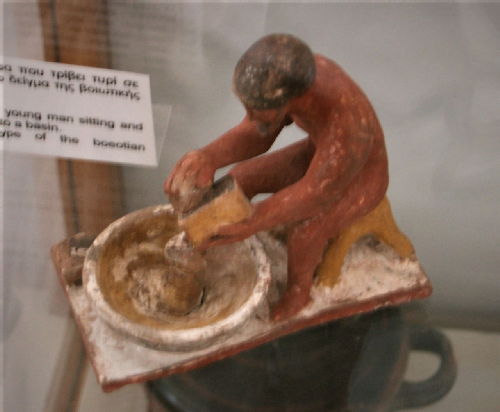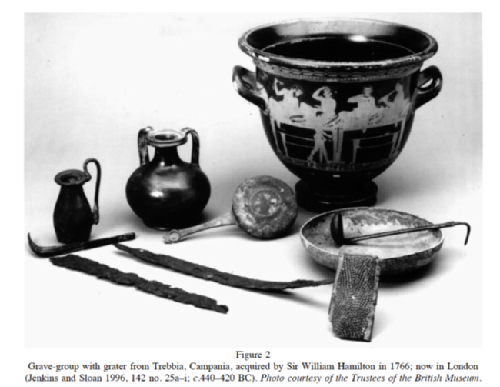Grating Cheese by Professor Michael Scott
 |
Terracotta figurine of a man grating cheese over a bowl (Thebes Museum).
(Author's own photograph). |
The first time I saw this little object I was a PhD student studying at the British School of Athens, on a tour of Boeotia, back in 2004. The group had headed to the old archaeological museum at Thebes: ancient columns were strewn about the garden (some being used as coffee tables), and the building itself looked like it had some claim to being a relic. But nothing could prepare me for the riot of painted colour that confronted me in the museum: grave reliefs still vibrantly painted, and in unremarkable cabinets sat a plethora of small terracotta objects, resplendent in technicolour.
One of these was the ‘cheese-grater’. Just 9.7cm in height and 11.2cm in length, the model depicted a man sitting on a stool bent over a bowl. A shining knife lay on the floor beside the bowl, and over the bowl he held a block of cheese in one hand and a cheese grater in the other. What seems to be grated cheese pours into the bowl beneath.
The brand new museum of Thebes (well worth a visit when next in Greece!) has this object on display, and it also takes pride of place on their website (you can see it here: https://www.mthv.gr/en/permanent-exhibition/archaic-period/#image-23). You can also get up close to it via a 3D laser scan, which allows you to see the object from every angle, as if it were in your hands. Check it out here: https://www.mthv.gr/en/virtual-museum/3d-models/terracotta-figurine-of-a-male-grating-cheese-into-a-basin/.
It’s objects like this, I think, that completely make you re-think what it was like to be surrounded by the material culture of the ancient Greek world. It’s not just the vibrant colour of the object, reminding you of the highly coloured world of the ancient Greeks (compared to our modern visions of ‘classical’ white marble and stone). It’s the fact that someone chose to make, buy and own (and display?) this object as an active choice. Someone thought this was a worthy (and/or perhaps fun?), miniature statue to have in their lives. For a world filled with epic heroes, gods, mighty armies, great poets, intelligent philosophers and powerful political demagogues, the humble cheese grater is a refreshing reminder of the normal everyday life of the ancient Greeks and the world around them.
Found back in 1908, the cheese-grater was part of a burial assemblage excavated near modern-day Rhitsona (most likely the necropolis of the ancient Boeotian polis of Mykalissos). The grave was dated via the ceramics to ca. 500 BC. This little terracotta figurine was one of the many items in the burial assemblage of grave 18, and was but one of a number of miniature terracotta figurines included with the deceased, including models of doves, tortoises, frogs, dogs, rabbits, the half figure of a female and a full figure reclining. This item was thus something the deceased, or those around him, thought not just appropriate to have with them in life but also in death.
Ancient Boeotians are renowned for having a fondness for miniature terracotta figurines conducting everyday tasks from an early date (another favourite of mine is of a barber cutting a seated person’s hair). Boeotia would too in later centuries become well-known for creating a style of human terracotta figurine that was copied in other parts of Greece too (the ‘Tanagra Figurine’). So the small terracotta model may well be understood as a ‘Boeotian thing’ – but why a cheese-grater? Compounding the importance of the question is that we know this is not a one-off: other models of cheese-graters have also been found (like that currently in the Museum of Fine Arts in Boston).
One way of answering this question is to look more widely at the use and meaning of cheese-grating in the ancient world (you never thought studying Classics would take you down this path did you – I certainly didn’t!).
In Homer’s Iliad (11.640ff), Nestor’s servant (Hecamede) prepares a special drink for him to share with the hero Machaon who has been wounded in battle (they have both been in the fighting):
“Therein the woman, like to the goddesses, mixed a potion for them with Pramnian wine, and on this she grated cheese of goat's milk with a brazen grater, and sprinkled thereover white barley meal; and she bade them drink, when she had made ready the potion. Now when both had drunk and quenched their parching thirst, and were enjoying the pleasure of their conversation.”
Now we may baulk at the idea of grating cheese on our wine, but it seems to have been just the ticket for two battle weary heroic souls. Moreover, archaeological excavations tell us that cheese-graters, as part of a heroic warrior’s key kit, was not just the stuff of Homeric epic. The oldest known cheese-graters (in Greek turoknestis - normally a piece of bronze/silver/copper [or even terracotta] pierced with lots of small holes to give it the rough edge to grate) to be found were made from bronze and found in warrior burials at the Toumba cemetery in Lefkandi dating to the 9thcentury BC.
Other surviving examples of cheese-graters have been found in a number of orientalising and elite 7th century BC burials along the Tyrrhenian seaboard of Italy. Here again they seem to be a key part of the ‘symposium drinking set’ buried with the elite deceased.
Potentially then the humble cheese-grater, and our terracotta cheese grater, actually carried heroic and elite sympotic connotations, considered as a natural part of a warrior’s/ elite’s personal property.
 |
Grave-group with grater from Trebbia, Campania (Ridgeway 1997). |
That militaristic connotation of the cheese-grater seems to echo down through into 5th century BCE comedy. In Aristophanes’s Clouds, in which the dog Labes is put on trial for eating the Sicilian cheese, a cheese-grater is called as a witness. The play parodies an Athenian general Laches, who has been put on trial for embezzlement of military funds during the Sicilian expedition (hence Labes/Sicilian cheese in the play). But there is another joke at work here, as the Athenian base of operations in Sicily was Catana (modern-day Catania). In Sicilian dialect, katana means a ‘grater’ and Catana was on occasion as a result called the cheese-grater city (Plutarch Dion 58.2).
So was this stunning little terracotta buried with someone ca. 500 BC in Boeotia as a neat, very Boeotian, way of linking into the long-standing heroic militaristic and elite meta-narrative of the cheese grater? It’s tempting to see it as such. But as for what this little object tells us about another cheese-grating mystery (Aristophanes’ description in Lysistrata of a sexual position as ‘the lioness on a cheese-grater’), well that is another story….
Bibliography:
R. Burrows & P. Ure (1908) ‘Excavations at Rhitsóna in Boeotia’ in The Annual of the British School at Athens, 14, 226-318.
C. Kerr Prince (2009) ‘The Lioness and the Cheese-Grater (Ar. Lys. 231-232) in Studi Italiani di Filologia Classica, 4th series, 7:2: 149 - 175.
L. A. Post (1932) ‘Catana the Cheese-Grater in Aristophanes’ Wasps’ in The American Journal of Philology 53(3) 265-266.
D. Ridgway (1997) ‘Nestor’s Cup and the Etruscans’ in Oxford Journal of Archaeology, 16 (3) 325-344.
B. Sparkes (1962) ‘The Greek Kitchen’ in The Journal of Hellenic Studies Vol. 82. 121-137
 |
This post was written by Michael Scott, Professor in Classics and Ancient History and Director of the Institute of Engagement at the University of Warwick. Michael is also President of the Lytham Saint Annes Classical Association, Trustee and Director of Classics for All and an Honorary Citizen of Delphi, Greece. He is the author of several books on the ancient Mediterranean world as well as ancient Global History; and has written and presented a range of TV and Radio documentaries for National Geographic, History Channel, ITV and the BBC. www.michaelscottweb.com @profmcscott |
 Jacqui Butler
Jacqui Butler

 Loading…
Loading…
Add a comment
You are not allowed to comment on this entry as it has restricted commenting permissions.